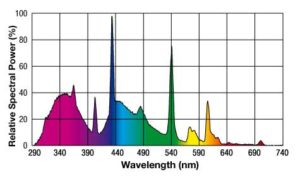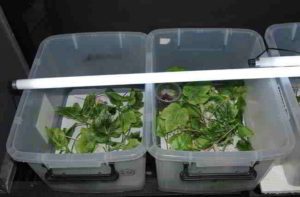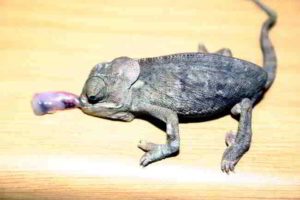UV light for chameleons
Keeping chameleons in captivity failed in the past due partly to a limited understanding of their need for ultra violet light. Sadly, the situation has only improved slightly today and the need for UV light for chameleons is too often ignored.
I still get photos of Veiled chameleons with chronic MBD from owners who thought they could get away without a UV light. They write to ask how they can ‘fix’ their pet’s MBD. In most, if not all, cases they can’t.
The correct use of UV light is essential for a healthy chameleon. But it may not be as straightforward as you think. Read on to learn why distance and strength can play a critical part.
Know your UV

There are three types of ultra violet light: UV-A (long wave), UV-B (medium wave) and UV-C (short wave).
UV-A is part of the chameleon’s visible spectrum. It allows it to see its surroundings in a slightly different way to humans but it is UV-B that is important for vitamin D3 synthesis in reptiles. UV-B has a wavelength in the range of 290 to 320nm (nanometres).
UV-C is harmful and is used in ultra violet sterilisers.
The process of vitamin D3 synthesis in the skin as a result of exposure to ultra violet light involves complex topics such as PTH (parathyroid) hormones and pre-vitamin D3 conversion. As such, these are outside the scope of this blog. It’s enough to repeat: UV light is essential for a healthy chameleon. It’s also crucial if a female is to lay viable eggs.
Generally, a UV light for chameleons does not produce heat. It should not be confused with other types of lighting, such as basking or Infra-Red lights.
The sun – the perfect UV light for chameleons
The cheapest source of UV-B is the sun. This is obviously far better than any artificial source. Anyone who has read any of my books or blogs elsewhere will know I’m a huge advocate of exposing chameleons to natural sunlight. But only in the right location and situation. Obviously, you must exercise common sense how you expose your chameleon. And not all climates are suitable.
Even a few hours outdoors each week will be beneficial. In South Africa, it was my habit to place my chameleons outside as much as possible, even in the winter. Unless the temperatures were below 16°C, I would put my Panther chameleons outside against a sunny wall and out of any cold winds during the middle of the day.
In Malaysia, I keep my adult Veiled chameleons outside 24 hours a day. However, the cages are placed so they get a mix of sun and shade. Daytime temperatures in the open can reach 36°C but inside the cages it rarely goes above 32°C.
The cages house small bushes so the chameleons can crawl among the leaves to escape the sun if they wish. An automated watering system helps keep the bottom of the cage moist and at a lower temperature, even on hot days.
Not all species would be survive outside in a hot, tropical climate.
There are subtle differences in behaviour under artificial light compared to natural sun light. Studies show that in the wild chameleons can regulate their ultra violet light exposure, moving in and out of the sun as required.
How much UV is natural?
Under artificial light, there is evidence that some species are attracted to the ultra violet light a bit like moths. This may mean they do not regulate their exposure as they would in the wild.
This is not necessarily as bad as it sounds when one compares outside UV and that from a UV light using a UV meter. On a sunny day at noon in Gauteng, a UV meter might read 450 mW/cm2. This may be reduced by cloud or by taking the reading earlier or later in the day but it is still quite intense.

It is worth noting that the altitude on the Highveld (between 1,500 and 1,700 metres above sea level) results in meter readings higher than at sea level. At lower altitudes a reading of 300mW/cm2 might be normal at noon on the equator. For comparison, a 5.0 ReptiGlo UV light for chameleons will register roughly 17 mW/cm2 at 30 cm from the tube.
Does this comparison mean that either a stronger light is needed indoors or that artificial light is ineffectual? No. If used correctly artificial light can be quite sufficient and beneficial. Using a stronger light would probably result in health issues, including eye damage.
UV Strength
The key thing to remember is the strength of the light falls off with distance from the source. The following chart for a 5.0 UV tube, shows this clearly:
| Strength of the UV as distance from the light increases | ||||||||||
| Distance in cm | 5 | 10 | 15 | 20 | 25 | 30 | 35 | 40 | 45 | 50 |
| mW/cm2 | 100 | 54 | 37 | 28 | 22 | 17 | 14 | 13 | 11 | 9 |
From this chart it can be seen that at 30cm the strength of the light is 17 mW/cm2. Research and experience show this is an acceptable reading for captive chameleons.
But the chart shows the further down the cage the chameleon travels away from the light source, the lower the ultra violet intensity. By 50cm the light is barely producing any worthwhile UV light.

Another point to bear in mind is that the last few centimetres at each end of the tube produce far less UV than the middle. Therefore, always use the longest tube you can for your cage.
The majority of UV lights on sale in South Africa as tubes normally have an effective lifespan of about nine months. I’ve tested several with a UV meter during use and found some still producing ultra violet at full strength several months after this. However, unless you’ve invested in a UV meter it’s better to assume that nine months is the limit.
Conclusion
If you’re planning on keeping a chameleon, it is essential you invest in UV lighting. If you skimp on this you will end up with a sick chameleon. The only alternative is exposure to direct natural sunlight.
Keeping a chameleon in a window will not work. When the sun hits the window, the temperatures in the chameleon cage are likely rise very quickly. Never put a glass cage outdoors, even with the lid off.
Most types of glass filter out the UV light for chameleons. That means that most conservatories and glasshouses will not work unless special glass is used.
The information shown above is for the ‘normal’ chameleons kept in captivity, e.g. Veiled, Panther, Carpets, etc. Veiled chameleons are especially prone to MBD and poor UV light is often a direct cause.
There are species that are not as dependent on UV, for example, certain Brookesias that spend their time on the forest floor. Montane species may come from areas with intense cloud cover but when it breaks, the altitude can mean the UV intensity is high. A normal UV set up should be used unless you find evidence to show the species has specific requirements.


Hello, I’m a new owner of a juvenile veiled chameleon. My husband always wanted one but I knew they needed special care so I held off. I have several tree frogs and have taken a masters Herpetology course taught by the Amphibian Foundation in Atlanta. That being said I was recently in a chain pet store getting crickets when I noticed a veiled chameleon trying to get my attention and scratching at the glass. His tank was almost bare and the poor thing had some white spots on his face almost like dried skin but he didn’t appear to be shedding. I asked about his temperament and how long they had him. They said a few weeks and that he was good except for when they housed him with another chameleon. At that point I knew these people where clueless and decided to bring him home to save him. I had a brand new Exo Terra 18,18,24 that hadn’t been set up yet so I put some dry hydro balls in the bottom, one live house plant, branches, vines, sticks and some new artificial plants that came with other tanks but that I never use with my frogs because I have bioactive setups. I’m using a new terra sky Exo terra full spectrum led light and a new uva, uvb led light purchased on Amazon. The first couple of days she ate very well. Several calcium dusted crickets and some wax worms the next day. I mist her cage at night making sure there are water droplets on the leaves and that during the day the tank drys out. My household temp is 76-78 and humidity about 50%. She has a was very social a mellow temperament for a veiled. I’ve only handled her once after I brought her home and I let her climb on me as she chose. However, in the last couple of days I’ve noticed her sleeping a lot even during the day and she’s not showing much interest in food. I’m concerned something is wrong. Any suggestions?
Hi Lindsey, I’ve sent you an email. You’re probably already doing this but misting should be done during the day and it should be a strong dosing of water that runs copiously off the leaves for several minutes. If possible, do this twice a day.
Good day. Would like to know what UVB light I sould get for my indoor enclousure. 1m high. 50x50cm wide. Pvc mesh. I stay in Mpumalanga and its hot and humid here.Would love to keep veiled cham outside for most of the afternoon…bit when weather is bad..what uvb light will work. I’ve been reading conflicting info? Some say Reptisun T5 ho 10.0 but we only get T8 in SA? Others say Arcadia 12% uvb T5?
Hi Monique, thanks for a good question. I’m not familiar with the two lights you’ve mentioned. However, I only ever used 5.0 UV lights. From my experience and research, if you’re keeping your Veiled outdoors for a couple of hours each day, they should get sufficient UV, especially in areas like Mpumalanga. The same wouldn’t necessarily be true if you were in a northern temperate zone like the UK or parts of the US. If the weather is bad for a day or so, there would be no need to supplement with UV. If the weather is poor for longer (too hot, too cold etc), then I aways used a 5.0. If you use a 10.0 (or 8.0) I would suggest putting the light slightly further away. If you look at the chart on the blog, you will see that the strength of the UV falls off dramatically with the distance from the light.
Like all advice, this is given based on normal circumstances. I assume that if they are outside, the chameleons are positioned sensibly: neither in direct sunlight without good shade if they need it or in dark shade so they can’t sun themselves.
The situation would be slightly different if it was a juvenile Veiled as its growing speed would need more UV, but that also depends on how much and how often you feed it. Aiming for slow and steady growth with Veiled is the best way. Overfeeding will often result in problems even with good UV.
Please send an email if you want to discuss this further.